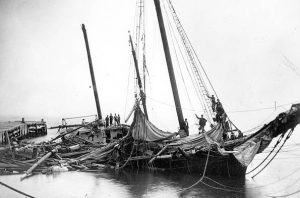
When winds blow across Lake Erie, they drag water levels from one end of the lake and pile it up on the other. Ships anchored along Cleveland’s western lakeshore often find themselves sitting on lake bottom, while the streets of Buffalo, NY, at the eastern end of the lake are flooded four and five-foot deep.
From the Buffalo Gazette, October 19, 1844:
Our city was visited last night by one of the most severe and destructive gales ever experienced here. The stone pier on the south side of the bay, considered impregnable to the assaults of previous storms had more than a third of its length washed into the bay.
Wharves throughout the city have been completely torn away and found scattered through the adjacent streets.
Numerous ships are found high and dry on city streets, especially past Michigan Street, between Ohio Street and the bay.
Wood, lumber, hogs, cattle and remnants of horses are to be found in the ravine up to Seneca Street. Carpenter’s tool chests, filled with tools, from the ship yard are also there.
The steeple of the Methodist Church on Niagara street, was blown off.
The engine and car house, scarcely completed, of the Buffalo and Attica Railroad Company, is completely demolished. A track of that same railroad from the depot on Washington Street to the Hydraulics, about three-quarters of a mile, washed away.
Up to 11 o’clock, 27 dead bodies have been brought to the court house. As near as we can learn the number missing and not yet found is about 15—making the whole number lost or missing 42. Dead bodies are constantly arriving. The flats is constantly crowded with people in search of friends and relatives.
Two servant girls were drowned in the cellar kitchen of Huff’s Hotel. One of them was an Irish girl named Ellen Hynam, who has no relatives in this country. The other was an American girl named Catherine Redding, whose parents reside at Cleveland. At 12 o’clock the bodies had not been recovered from the cellar.
Canal boats are seen scattered throughout the city. The Erie Canal has sustained considerable damage. Several breaches were made in its walls between the city and Black Rock. It is estimated that the repairs will cost from $10,000 to $15,000.
The Common Council set a meeting Saturday afternoon, for the purpose of devising measures for relief of sufferers of the gale. The sum of $400 was placed at their disposal. They prepared a place of resort in the basement of the Mohawk Market where the distressed and destitute found food and a temporary asylum. The Mayor appointed 25 additional watchmen to protect the properties of the sufferers. A call then went out for food, and clothing especially, because most left their homes with nothing but their night clothing and lost everything else. The charitable rendered effectual assistance by sending old clothing of any kind to the Mohawk Market, where it will be judiciously dispensed by the committee. As always, Buffalo citizens are responding generously.